Solid timber recovery and economics of short-rotation small-diameter eucalypt forestry
This report was prepared for Future Forests Research Ltd (FFR) by Scion.
Authors:
Dean Satchell, Sustainable Forest Solutions, R.D. 1 Kerikeri, Northland 0294. +64 21 2357554
James Turner, Scion, Private Bag 3020 Rotorua 3010. +64 7 3435899
Date: June 2010
Appendix 1: Assumptions in Discounted Cash Flow Analysis
Appendix 2: Prices and values of timber in New Zealand used for estimating board prices
Appendix 3: Timber grading
Appendix 4: Sawmilling methodology
Appendix 5: Glossary of terms
Spreadsheet 1: Kaingaroa Compartment 1194 E. regnans economic value (Microsoft Excel macro-enabled workbook 3.6 MB)
Spreadsheet 2: Optimal rotation and stocking for E. regnans (Microsoft Excel macro-enabled workbook 864 KB)
Treegrower article »
Results
Logs and harvesting
Log end-splits were observed to increase during the storage time but at worst were rated as only moderate even 28 days after harvest.
Sawmilling, seasoning, machining and grading
Results of the sawing and product recovery are given in Tables 3 and 4.
Taper of board thickness from the middle towards the ends of boards was evident, but appeared to be a minor issue apart from having to make sure that stacks were built level. This taper was caused by slight bending of the log from tension release during sawing of each board. The green thickness dimensions used (Table 2) appear to compensate for this affect at the log lengths sawn in this study, by neither limiting grade nor sawn timber recoveries.
Of the 25.0 m3 of logs sawn, 14.0 m3 of green boards were recovered (11.6 m3 nominal - 46%), with 10.75 m3 of final product recovery (43%).
Table 3: Product recoveries
| Sawn timber | % of total log volume |
% of nominal sawn timber recovery |
% of product recovery volume |
|---|---|---|---|
| Total green-sawn recovery | 55.8 | ||
| Total nominal recovery | 46.3 | ||
| Select grade > 89 cm length | 29.4 | 63.9 | 68.3 |
| Standard grade > 89 cm length | 5.9 | 12.9 | 13.8 |
| High Feature grade > 89 cm length | 3.1 | 6.7 | 7.1 |
| Clear Cutting lengths 30-59 cm | 0.4 | 0.9 | 1.0 |
| Clear Cutting lengths 60-89 cm | 1.2 | 2.6 | 2.8 |
| Fillets | 3.0 | 6.5 | 7.0 |
| Total product recovery | 43.0 | 93.6 | |
| Defect | 6.4 |
Product recovery was high, accounting for 93.6% of nominal sawn timber recovery. Recovery of valuable grades (select and standard) was also high, accounting for 76.8% of nominal sawn timber recovery.
Only 6.4% of the nominal sawn timber was lost due to degrade. Branch defects, knots, decay and excessive checking (Box) accounted for 4.3% of sawn timber recovery. Decay and excessive checking were observed to be primarily associated with branch defects. End splits accounted for 1.4% and skip caused by excessive collapse 0.5% of nominal sawn recovery. Defect resulting from sawmilling and sizing (want, wane and skip caused by undersizing) was only 0.1% of nominal sawn timber recovery.
Spring and bow did not increase during drying. All boards were assessed as meeting grading rules for spring and bow on the sawn and seasoned product at full length. No cupping or twist was present in the sawn timber and caused no loss of grade recovery. Visible shakes or heart fractures were not present and caused no loss of grade recovery.
Surface checking was present in 6.3% of boards meeting grade criteria. The average number of checks (5cm length) was 3.8 per board where surface checking was present.
Observations:
- Gum veins (kino) were present but not numerous. These had little negative impact on grades.
- There was no sign of insect damage.
- Incidence of end-splits, checks and collapse all appeared to relate to individual tree differences. Two logs were sawn from each tree, and it was observed that these issues were all relatively consistent between logs from the same tree and highly variable between trees. These features could potentially become important criteria for future selection and breeding work.
- End-splits (1.4%) did not appear to increase on drying.
- Internal checking was not measured, despite the higher levels of internal checking which can be expected from lower density ash timber (Haslett 1988(2)). For the dimensions sawn and the products targeted in this report it was decided that internal checking is not likely to influence value. The incidence of internal checking was observed to be low in timber docked for the two product value trials. If internal checking were to be assessed and found negligible, turned and moulded products could potentially be included in the product mix with confidence.
- Some decay was observed in boards. However, this was negligible.
- Checks not meeting grade allowances were rare.
- Collapse causing skip was negligible at 0.5%.
- Density variation was strongly evident between boards from different trees but not between boards from the two logs of the same tree. This was not measured however.
The percentage of branch defects within logs was unrelated to log diameter (Figure 5).
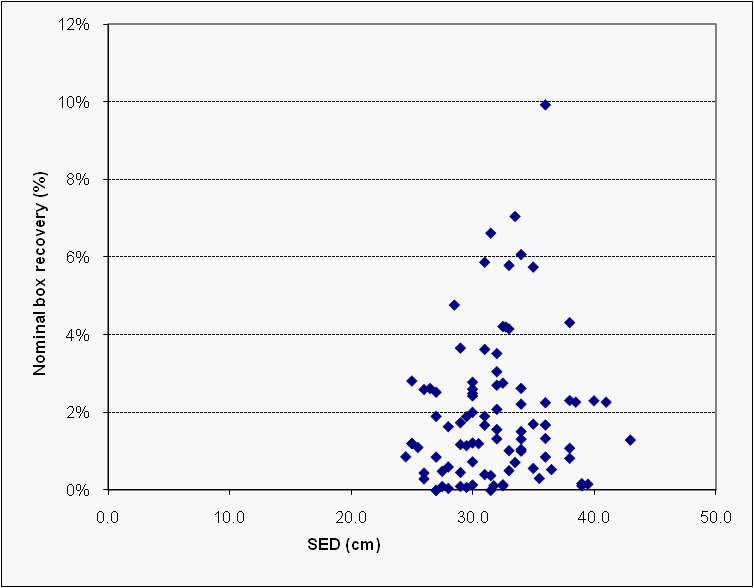
Sawlog value
The relationship of value (conversion return) and log SED of sawlogs from the sawing study was reasonably strong (R2 = 0.495; Figure 6). This relationship was used in the economic analysis of the stand used for the sawing study and rotation and stocking to estimate the value of sawlogs.
Other influences on conversion returns that may explain the remaining 50% of variation in conversion returns include:
- Individual log variability issues such as sweep.
- Inaccuracy of the initial half-log cut which should be exactly through the pith to optimise individual log recoveries.
- Other sawmill operator judgement calls which influence recoveries from each log.
- Variability in length: diameter ratios for individual logs which would vary from the optimum.
These influences are routine sawmilling issues which necessitated a large sample set of logs.
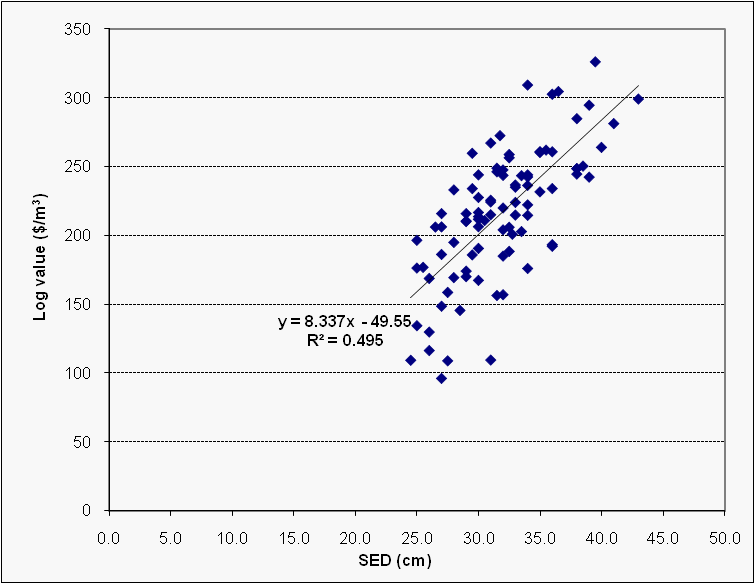
Log SED explained almost 50% of the variation in log value. The relationship implied that a 1 cm increase in log SED contributed to an average $8.34/ m3 increase in log value. The increase in net log value with increased log SED is due to two main factors; (i) the increased timber recovery per m3 of log sawn (Figure 7), and (ii) the increased milling efficiency per m3 of timber recovered (conversion factor - Figure 8).
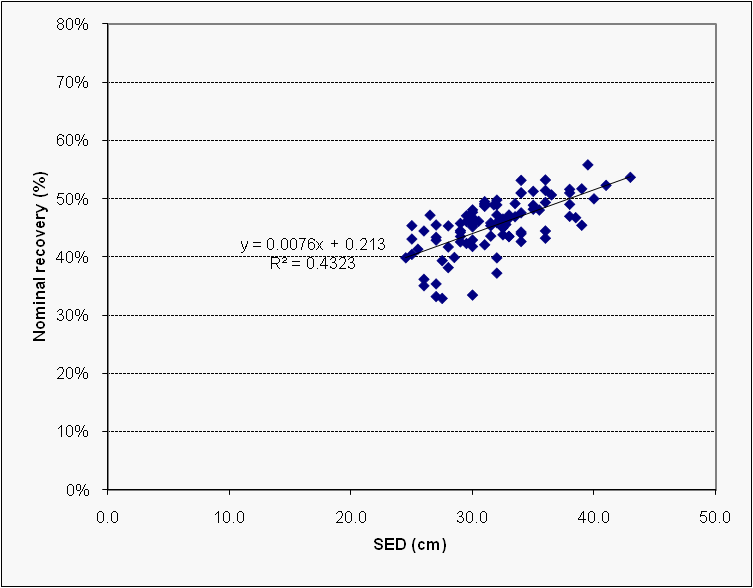
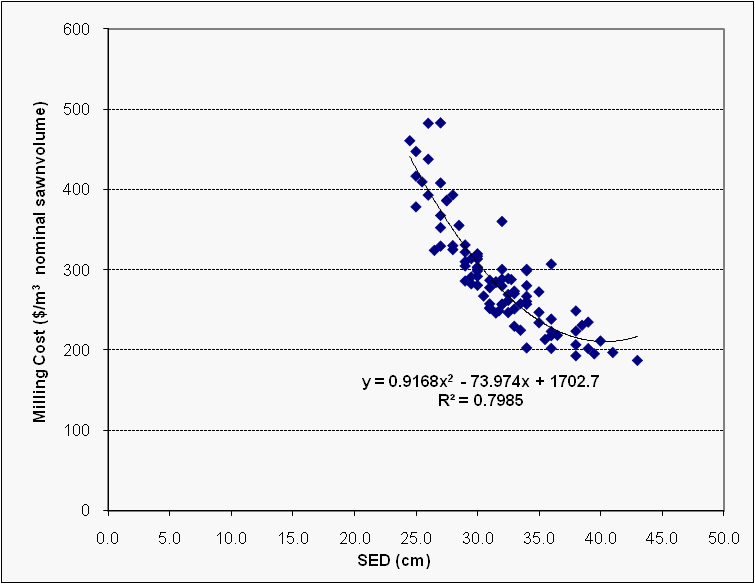
Economic value of case study stand
The value of the case study stand was estimated to be $10,292 per ha (internal rate of return of 16.8%) at age 18 years using an 8.0% discount rate.
The high value of the stand is attributed to three main factors:
- The large proportion of sawlogs (SED > 25 cm, with no significant sweep, and no significant malformation) within the stand; 60.5% by volume.
- The high prices allowed for E. regnans sawn timber (Appendix 1), which meant that sawlog value accounted for over 95% of the stand value.
- The high product recovery, 43% of total log volume, due to an absence of end splits, warp, internal checking, etc, and the higher quality grades (Select and Standard) being a significant proportion of the product recovery (74%).
Lumber price sensitivity analysis showed that with 10% lower prices for all sawn timber grades and fillets, the estimated net present value of the stand was almost halved, but was still excellent; $7,300 per ha (internal rate of return 15.2%).
By way of comparison, the estimated internal rate of return for E. grandis grown for sawn timber on a 15 year rotation in Brazil in 2006 was 21.4% (Cubbage et al. 2010). In comparison to this study the return for E. grandis was achieved from lower establishment costs (US$490/ ha, approximately NZ$820/ ha), a higher yield of 450 m3/ ha, and lower product prices; pulpwood stumpage price of US$24 (NZ$40), and a small sawn timber stumpage price of US$37 (NZ$62).
Impact of rotation and stocking on stand economic value
Figure 9 shows the estimated impact of rotation (years) and stocking (stems per hectare) on the net present value (using an 8% discount rate) of E. regnans sawlogs. The spiked nature of the curves reflects the use of the 'average tree' for a stand (see Appendix 1) because diameter distributions were not available when calculating log volumes. This means that when the SED for a log in the average tree goes above 25 cm (minimum sawlog SED) the value of the stand increases, due to increased sawlog value.
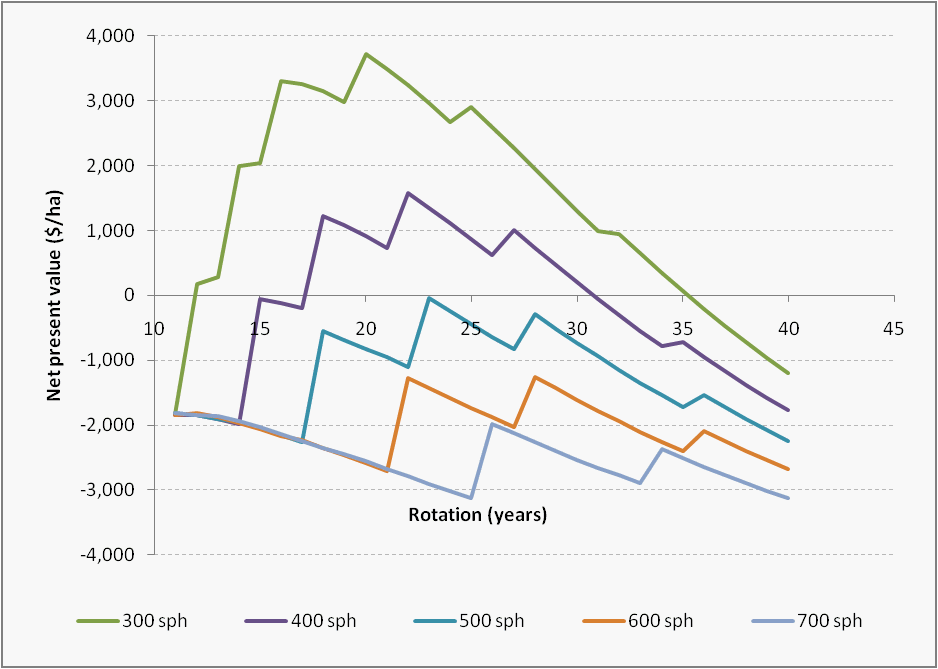
Stand value increases with lower final crop stocking are due to two factors:
- the larger SED of logs from the stand average tree resulting in significant volumes of sawlogs by age 20; 41% for 400 stems/ ha and 67% for 300 stems/ ha;
- the high value of E. regnans sawn timber which results in a large proportion of stand value attributed to sawlog conversion returns; 81% for 400 stems/ ha at age 20 years.
The estimated increase in stand value with lower stocking should be tempered by two considerations. Firstly, the shape of the relationship between SED and log conversion returns beyond 43 cm is unknown. In this study we have taken the conservative approach that for logs greater than 43 cm SED we assumed log value was constant. Secondly, lower stockings may lead to increased negative impact of branch size on sawn timber recoveries. Furthermore, we assume that a log from two trees with the same diameter and height, but of different ages, will still have the same grade recovery, and hence conversion return. This assumption was made because we only had data from an 18-year old stand for estimating conversion returns. It therefore is important to recognise that grade recovery may change with tree age (independent of tree diameter) due to changes in wood density and grade-limiting defect that might influence grade recovery.
The economically optimal rotation appears to be around 20 to 25 years (for the 8% discount rate used in this study).
With 10% lower prices for all sawn timber grades and fillets, the estimated net present value is almost halved, though estimated returns at age 20 to 25 years for stands thinned to 300 stems per ha are still good (Figure 10).
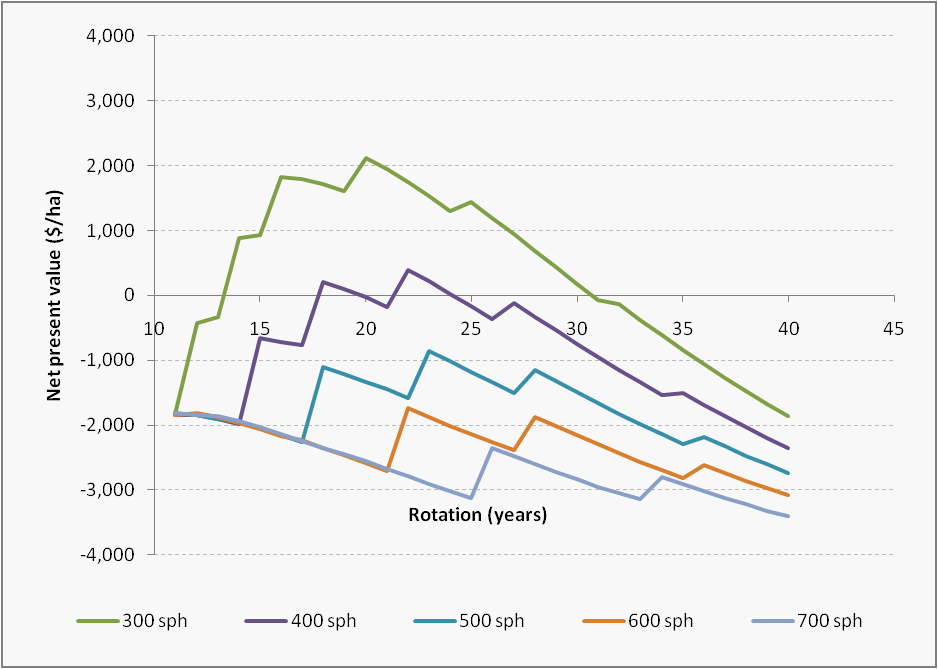
Utilisation and product value trials
(i) Flooring and panelling
Docking of defect timber equated to 10% of ungraded, blanked timber in order to produce a flooring and panelling product. This result is similar to overall product recovery (Table 3). The incidence of internal checking was observed to be low. The timber was profiled slightly wider than the usual 83 mm × 19 mm, reflecting the excessively oversized green-sawn width. The timber was used for panelling and flooring with no further docking apart from fitting to joists or studs.
(ii) Laminated panels
The incidence of internal checking observed from docking the 50 × 50 mm timber appeared to be higher than the 25 mm thickness timber. Slight internal checking was present in the end section of 25% of the individual panel laminates. These checks were mostly small (< 0.5 mm wide) and did not detract noticeably from their appearance. Checks between 0.5 and 1.0 mm were found in 10% of the timber. A solid-timber wardrobe was constructed from these to verify the dimensional stability and decorative appearance of laminated E. regnans panels.
Next: Discussion »
Disclaimer: This report has been prepared by New Zealand Forest Research Institute Limited (Scion) for Future Forests Research Limited (FFR) subject to the terms and conditions of a Services Agreement dated 1 October 2008.The opinions and information provided in this report have been provided in good faith and on the basis that every endeavor has been made to be accurate and not misleading and to exercise reasonable care, skill and judgement in providing such opinions and information. Under the terms of the Services Agreement, Scion's liability to FFR in relation to the services provided to produce this report is limited to the value of those services. Neither Scion nor any of its employees, contractors, agents or other persons acting on its behalf or under its control accept any responsibility to any person or organisation in respect of any information or opinion provided in this report in excess of that amount.

 Farm Forestry New Zealand
Farm Forestry New Zealand

